Course Information
Course Number: ARCH 1231
Course Title: BUILDING TECHNOLOGY I
Course Description: ARCH 1231 is an introduction to basic materials of construction and the fundamental principals of orthographic projection and architectural drafting. The coursework includes documenting existing conditions, development of a plan, elevation, section and assembly details supported by text-based study of material properties and applications.
Credits / Hours: 3 CREDITS / 5 HOURS (1 lecture + 4 lab)
Pre/Co-requisites: ARCH 1101 Introduction to Architecture
Course Resources
- Required text: Ching, Francis. Building Construction Illustrated 6th Ed. John Wiley and Sons, 2020.
- Required Supplies
Course Coordinators
- Professor Robert Zagaroli 3rd , Course Coordinator
- Professor Michael Loo, Interim and Co-Coordinator
- Professor Robert Christo, Interim and Co-Coordinator
Note: This Course was authored by Professor Jason Montgomery through 2022. Work not specifically credited to other professors, or students is thanks to the dedication of Professor Montgomery.
Course Topics + Structure
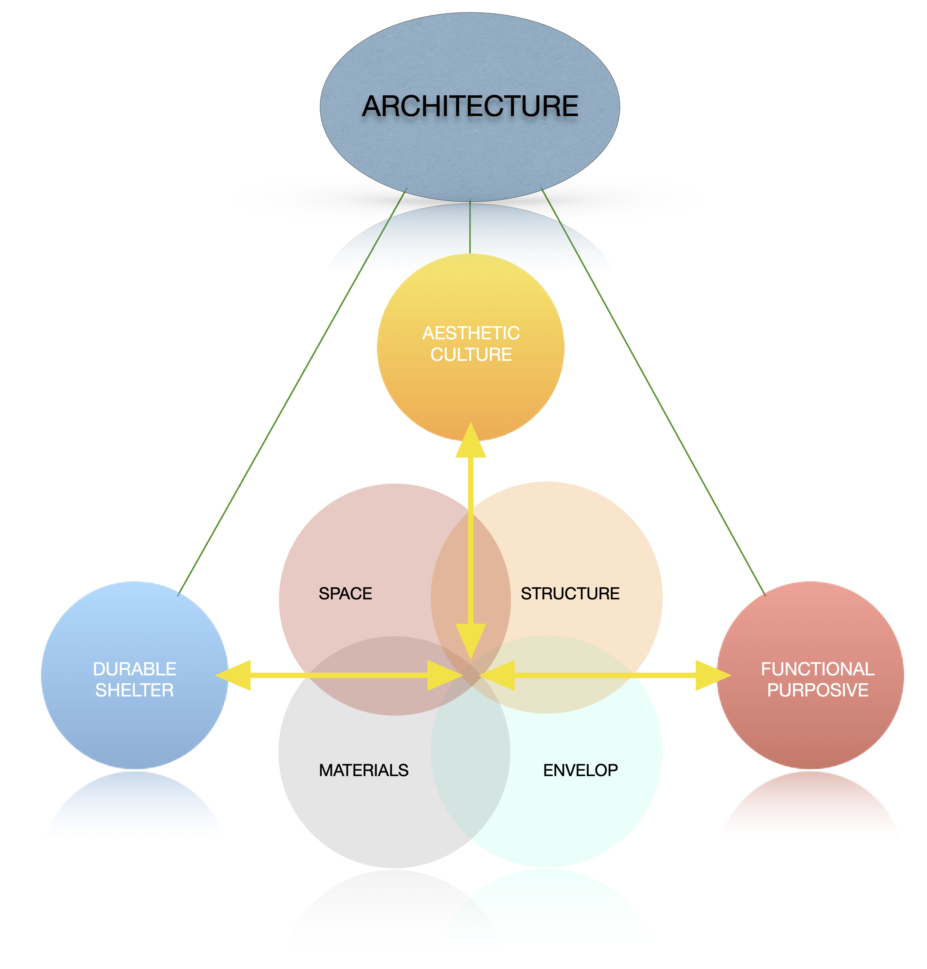
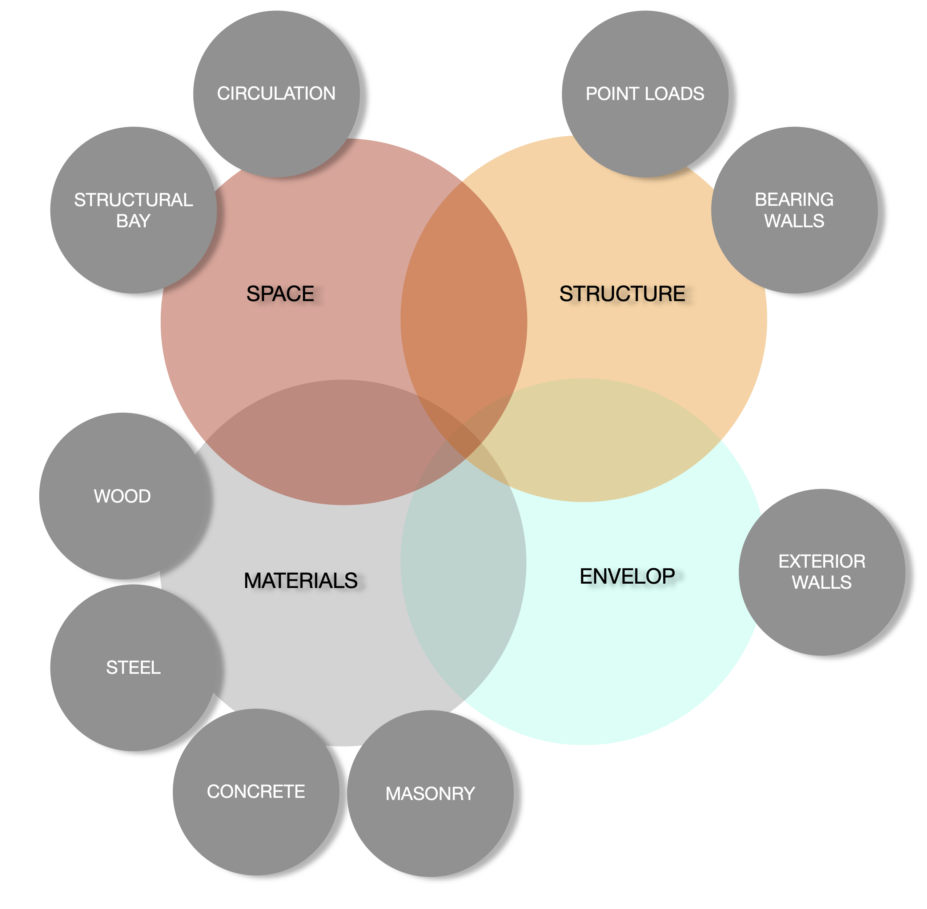
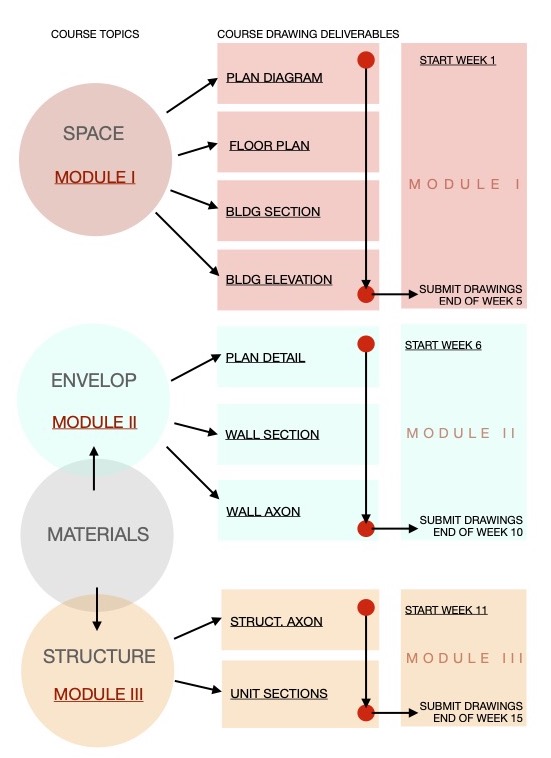
Learning Outcomes
General Education Learning Outcomes / Assessment Methods
| Learning Outcomes | Assessment Methods |
| Upon successful completion of this course the student shall be able to: | To evaluate the students’ achievement of the learning objectives, the professor will do the following: |
| 1. Develop Knowledge from the range of architectural disciplinary concepts presented in the course. | 1. Review student notebooks, observe student participation in class discussions, and review student applications of disciplinary concepts in drawing assignments. |
| 2. Use the texts assigned in the course as well as background knowledge from within the discipline in order to Draw Inferences from the material. | 2. Use a pre and post written exam to assess students’ development and achievement over the course of the semester. |
| 3. Apply Information from the reading within the discipline. | 3. Review student applications of disciplinary concepts in drawing assignments. |
National Architectural Accrediting Board (NAAB) Students Criteria (SC) / Assessment Methods
| Learning Outcomes | Assessment Methods |
| Upon successful completion of this course the student shall be able to: | To evaluate the students’ achievement of the learning objectives, the professor will do the following: |
| 4. (SC.4) Technical Documentation (introduced) How the program ensures that students understand the established and emerging systems, technologies, and assemblies of building construction, and the methods and criteria architects use to assess those technologies against the design, economics, and performance objectives of projects. | 4. Review students’ final drawing sets and reading notes and assess for an understanding of established systems, technologies, and assemblies of building construction by evaluating: a. The comprehensiveness and accuracy of students’ notes b. The accuracy of student technical documentation of 2d and 3d drawings and details of assemblies of building construction |
Course Specific Learning Outcomes / Assessment Methods
| Learning Outcomes | Assessment Methods |
| Upon successful completion of this course the student shall be able to: | To evaluate the students’ achievement of the learning objectives, the professor will do the following: |
| 5. Layout plan drawings by hand and with digital tools. | 5. Review student plan assignments for accuracy and application of line weights and drawing conventions. |
| 6. Understand and apply basic principles of structural characteristics of materials following rules of thumb. | 6. Review student drawing assignments for accurate application of rules of thumb to sizing structural elements for a specific span. |
Teaching/Learning Methods
- This course combines class discussions based on the readings, case study investigations, and technical drawing labs.
- Students are required to maintain a combined notebook/sketchbook for all readings and case study investigations.
- Students will learn to develop rigorous architectural drawings by hard line scaled hand drafting.
Technology + Home Setup Requirements
- Students need access to a device for video conference participation in the course meetings using Zoom.
- Students need to purchase a drawing work surface with parallel or set up a technical drawing desk surface approximately 18″x24″ with either a parallel rule, t-square, or rolling ruler.
Schedule
Topics will be covered in the order below unless otherwise noted during the semester. For more information see the detailed schedule on your section’s course site.
- Module 1 Drawings: Geometry and Order Diagram, Case study floor Plan, Section, and Elevation.
- Module 1 Reading Topics + Notes/Sketches:
- The Building + Building Systems
- Means of Egress
- Stairs
- Module 2 Drawings: Exterior Wall Details: Plan, Section, Axon
- Module 2 Reading Topics + Notes/Sketches:
- Building Materials
- Masonry Exterior Wall Assemblies
- Moisture and Thermal Performance
- Windows
- Module 3 Drawings: Structural System Study
- Module 3 Reading Topics + Notes/Sketches:
- Structural Forces and Components
- Structural Systems (Steel)
- Structural Systems (Concrete, Precast, Wood)
Reading List
Follow this link to the course required reading list: READING LIST LINK
Grading Policy
BY MODULE:
- 30% Module 1 (Drawings + Reading Presentations + Notes/Sketches)
- 40% Module 2 (Drawings + Reading Presentations + Notes/Sketches)
- 26% Module 3 (Drawings + Reading Presentations + Notes/Sketches)
- 4% Participation + Class Reflections
BY LEARNING ACTIVITY:
- 63% Drawing Assignments
- 33% Notes/Sketches
- 4% Class Participation
GRADE SHEET: DOWNLOAD Grade Sheet
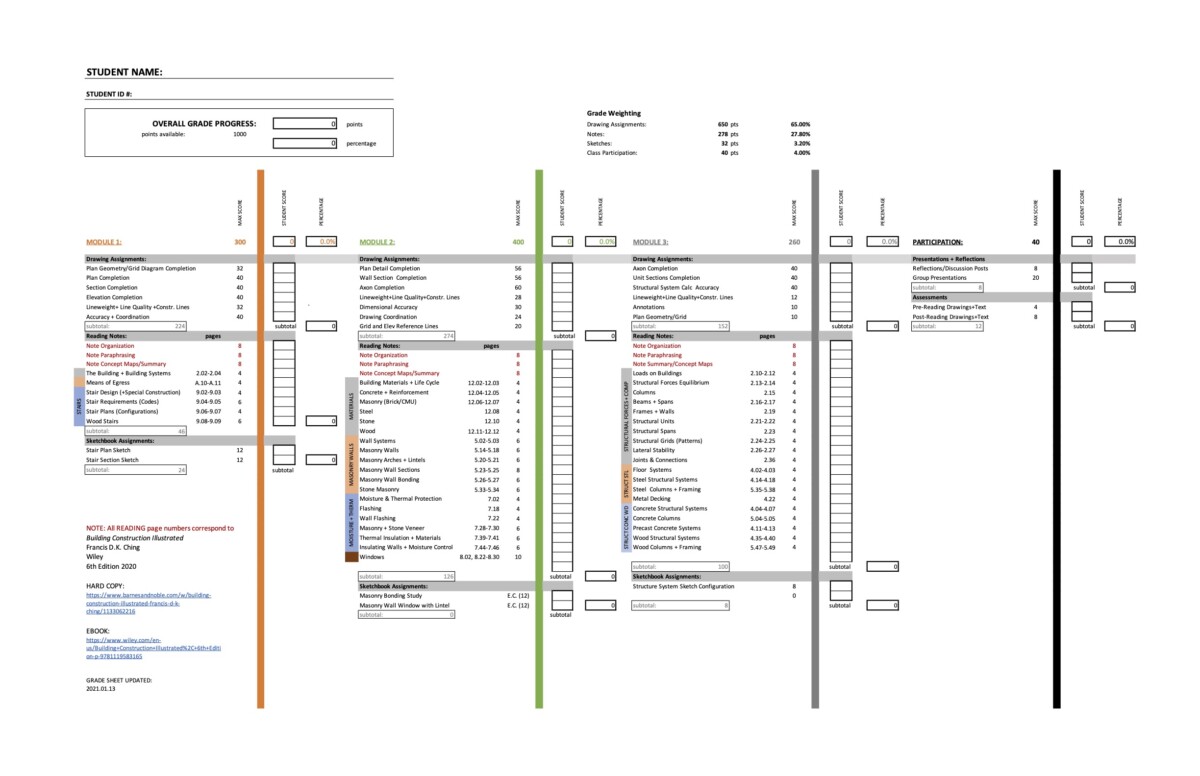
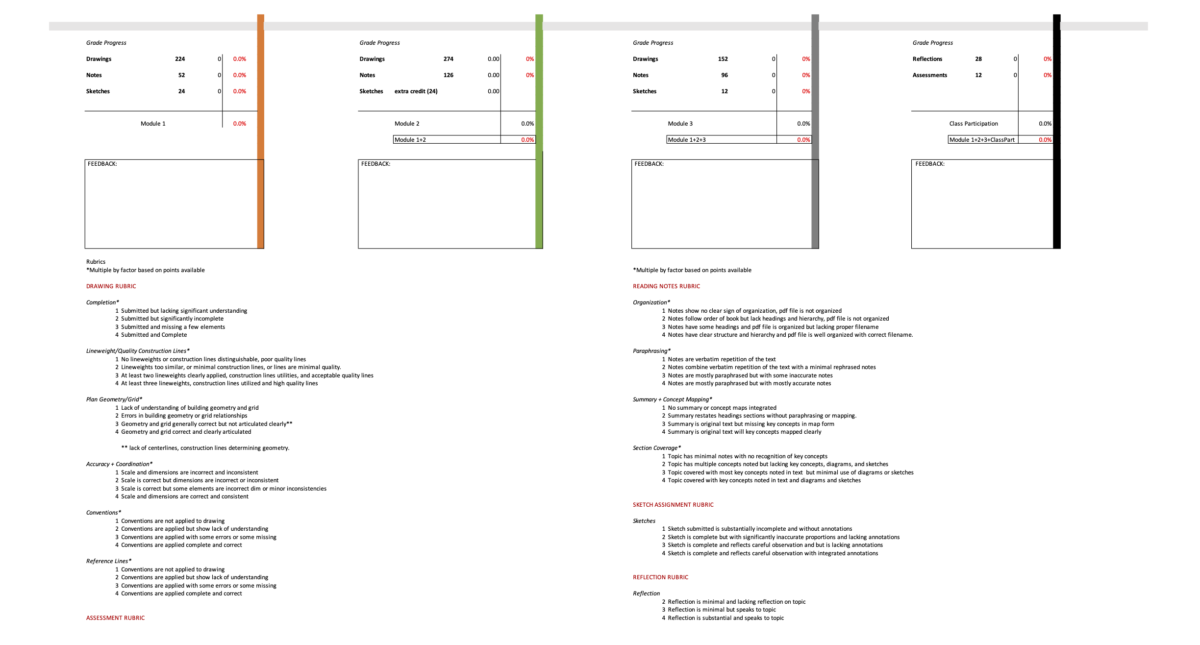
Submission Formatting Requirements:
All coursework must strictly follow the course formatting requirements. Follow this link for the detailed submission formatting requirements: Submission Formatting Requirements
Class Etiquette & Netiquette
All students are expected to attend all class sessions fully. It is HIGHLY preferred, but not required, for all students to have live video turned on during class time. I believe we build a better, more engaging community together when we can see each other during class.
All students are asked to manage their audio such that background noise does not distract from the class discussion or presentation.
Group presentations are a required aspect of this course. All students are expected to communicate fully with their group as required to prepare for all presentations. All students are expected to fully participate in the presentations.
Diversity and Inclusive Education
This course welcomes students from all backgrounds, experiences and perspectives. In accordance with the City Tech and CUNY missions, this course intends to provide an atmosphere of inclusion, respect, and the mutual appreciation of differences so that together we can create an environment in which all students can flourish. It is the instructor’s goal to provide materials and activities that are welcoming and accommodating of diversity in all of its forms, including race, gender identity and presentation, ethnicity, national origin, religion, cultural identity, socioeconomic background, sexuality and sexual orientation, ability, neurodivergence, age, and etc. Your instructor is committed to equity and actively seeks ways to challenge institutional racism, sexism, ableism and other forms of prejudice. Your input is encouraged and appreciated. If a dynamic that you observe or experience in the course concerns you, you may respectfully inform your instructor without fear of how your concerns will affect your grade. Let your instructor know how to improve the effectiveness of the course for you personally, or for other students or student groups. We acknowledge that NYCCT is located on the traditional homelands of the Canarsie and Lenape peoples.
Attendance/Participation
No more than 10% absences are permitted during the semester. For the purposes of record, two late arrivals are considered as one absence. Exceeding this limit will expose the student to failing at the discretion of the instructor due to lack of class participation and mastery of class material.
Academic Integrity Policy
Students and all others who work with information, ideas, texts, images, music, inventions and other intellectual property owe their audience and sources accuracy and honesty in using, crediting and citation of sources. As a community of intellectual and professional workers, the college recognizes its responsibility for providing instruction in information literacy and academic integrity, offering models of good practice, and responding vigilantly and appropriately to infractions of academic integrity. Accordingly, academic dishonesty is prohibited in The City University of New York and is punishable by penalties, including failing grades, suspension and expulsion. More information about the College’s policy on Academic Integrity may be found in the College Catalog.
Examples of academic dishonesty in the this course include but are not limited to: tracing other student’s work, copying other student’s notes, submitting or presenting work developed in a previous semester, submitting another student’s work as your own.
Print this page

